Queen Elizabeth The Queen Mother
Elizabeth Angela Marguerite Bowes-Lyon[b] (4 August 1900 – 30 March 2002) was Queen of the United Kingdom and the Dominions of the British Commonwealth from 11 December 1936 to 6 February 1952 as the wife of King George VI.Born into a family of British nobility, Elizabeth came to prominence in 1923 when she married Prince Albert, Duke of York, the second son of King George V and Queen Mary.[4] In 1936, Elizabeth's husband unexpectedly ascended the throne as George VI when his older brother, Edward VIII, abdicated in order to marry American divorcée Wallis Simpson.[c] The location of Elizabeth's birth remains uncertain, but reputedly she was born either in her parents' Westminster home at Belgrave Mansions, Grosvenor Gardens, or in a horse-drawn ambulance on the way to a hospital.After returning to private education under a German Jewish governess, Käthe Kübler, she passed the Oxford Local Examination with distinction at age thirteen.[19] At the same time, Elizabeth was courted by James Stuart, Albert's equerry, until he left the prince's service for a better-paid job in the American oil business.[29] Following a wedding breakfast at Buckingham Palace prepared by chef Gabriel Tschumi, Elizabeth and Albert honeymooned at Polesden Lacey, a manor house in Surrey owned by the wealthy socialite and friend Margaret Greville.[30] After a successful royal visit to Northern Ireland in July 1924, the Labour government agreed that Albert and Elizabeth could tour East Africa from December 1924 to April 1925.[31] The Labour government was defeated by the Conservatives in a general election in November (which Elizabeth described as "marvellous" to her mother)[32] and the Governor-General of Anglo-Egyptian Sudan, Sir Lee Stack, was assassinated three weeks later.[37] In New Zealand she fell ill with a cold and missed some engagements, but enjoyed the local fishing[38] in the Bay of Islands accompanied by Australian sports fisherman Harry Andreas.Just months into Edward's reign, the King's decision to marry the American divorcée Wallis Simpson caused a constitutional crisis that resulted in his abdication.[5] Claims that Elizabeth remained embittered towards Wallis were denied by her close friends; the Duke of Grafton wrote that she "never said anything nasty about the Duchess of Windsor, except to say she really hadn't got a clue what she was dealing with".After the Munich Agreement of 1938 appeared to forestall the advent of armed conflict, the British prime minister Neville Chamberlain was invited onto the balcony of Buckingham Palace with the King and Queen to receive acclamation from a crowd of well-wishers.[51] While broadly popular among the general public, Chamberlain's policy towards Hitler was the subject of some opposition in the House of Commons, which led historian John Grigg to describe George VI's behaviour in associating himself so prominently with a politician as "the most unconstitutional act by a British sovereign in the present century".[59] The tour was designed to bolster trans-Atlantic support in the event of war, and to affirm Canada's status as an independent kingdom sharing with Britain the same person as monarch.[60][61][62][63] According to an often-told story, during one of the earliest of the royal couple's repeated encounters with the crowds, a Boer War veteran asked Elizabeth, "Are you Scots or are you English?"Her visits initially provoked hostility; rubbish was thrown at her and the crowds jeered, in part because she wore expensive clothes that served to alienate her from people suffering the deprivations of war.[5] She explained that if the public came to see her they would wear their best clothes, so she should reciprocate in kind; Norman Hartnell dressed her in gentle colours and avoided black to represent "the rainbow of hope"."[74] Though the King and Queen spent the working day at Buckingham Palace, partly for security and family reasons they stayed at night at Windsor Castle about 20 miles (32 km) west of central London with their daughters.[77] French prime minister Édouard Daladier characterised Elizabeth as "an excessively ambitious young woman who would be ready to sacrifice every other country in the world so that she may remain Queen.[88] After a lung resection, he appeared to recover, but the delayed trip to Australia and New Zealand was altered so that Princess Elizabeth and her husband, the Duke of Edinburgh, went in the King and Queen's place in January 1952.The British ambassador and his wife, Anthony and Sheila Parsons, noted how the Iranians were bemused by her habit of speaking to everyone regardless of status or importance, and hoped the Shah's entourage would learn from the visit to pay more attention to ordinary people.[116] However, Burke's Peerage had listed the sisters as dead, apparently because their mother, Fenella (Elizabeth's sister-in-law), "was 'extremely vague' when it came to filling in forms and might not have completed the paperwork for the family entry correctly".[125] On 1 August 2001, Elizabeth had a blood transfusion for anaemia after suffering from mild heat exhaustion, though she was well enough to make her traditional appearance outside Clarence House three days later to celebrate her 101st birthday.Nevertheless, she flew to Windsor by helicopter, and so that no photographs of her in a wheelchair (which she hated being seen in) could be taken—she insisted that she be shielded from the press[136]—she travelled to the service in a people carrier with blacked-out windows,[137][138] which had been previously used by Margaret.[136][139] On 5 March 2002, Elizabeth attended the luncheon of the annual lawn party of the Eton Beagles and watched the Cheltenham Races on television; however, her health began to deteriorate precipitously during her last weeks, after she retreated to Royal Lodge for the final time.[150] At her request, after her funeral the wreath that had lain atop her coffin was placed on the Tomb of the Unknown Warrior, in a gesture that echoed her wedding-day tribute 79 years before.In his official biography, William Shawcross portrays Elizabeth as a person whose indomitable optimism, zest for life, good manners, mischievous sense of humour, and interest in people and subjects of all kinds contributed to her exceptional popularity and to her longevity."[170] Emine Saner of The Guardian suggests that with a gin and Dubonnet at noon, red wine with lunch, a port and martini at 6 pm and two glasses of champagne at dinner, "a conservative estimate puts the number of alcohol units she drank at 70 a week".[183][185] She left the bulk of her estate, estimated to be worth between £50 and £70 million, including paintings, Fabergé eggs, jewellery, and horses, to her surviving daughter, Queen Elizabeth II.



















Elizabeth IIElizabeth the Queen Mother (disambiguation)The Queen Mother (disambiguation)Richard StoneQueen consort of the United KingdomBritish DominionsCoronationEmpress consort of IndiaHitchinLondonRoyal LodgeKing George VI Memorial ChapelGeorge VIPrincess Margaret, Countess of SnowdonNoble familyBowes-LyonClaude Bowes-Lyon, 14th Earl of Strathmore and KinghorneCecilia Cavendish-BentinckQueen of the United KingdomDominionsBritish CommonwealthKing George VIEmpress of IndiaBritish Rajher husband diedQueen Elizabeth IIBritish nobilityshe married Prince Albert, Duke of YorkKing George VQueen MaryMargaretascended the throne as George VIEdward VIIIabdicatedWallis Simpsonqueen consortSecond World Wardeath of Queen MaryBritish royal familyher deathClaude Bowes-LyonLord GlamisEarl of Strathmore and KinghornePeerage of ScotlandWilliam Cavendish-Bentinck, 3rd Duke of PortlandRichard Wellesley, 1st Marquess WellesleyArthur Wellesley, 1st Duke of WellingtonWestminsterBelgrave MansionsGrosvenor GardensForbes HouseHam, LondonLouisa ScottEnglish country houseSt Paul's Walden BurySt Paul's WaldenGlamis CastleScotlandXenophonAnabasisOxford Local Examinationdeclared warGermanyFergusBlack Watch RegimentBattle of LoosMichaelprisoner of warconfirmedScottish Episcopal ChurchForfarWedding of Prince Albert and Lady Elizabeth Bowes-LyonPrince Albert, Duke of YorkKing George VJames Stuartequerrythe weddingPrincess MaryViscount LascellesKashmirWestminster Abbeythe Unknown WarriorHer Royal HighnessDuchess of YorkBuckingham PalaceGabriel TschumiPolesden LaceySurreyMargaret Grevillewhooping coughPhilip de LászlóNorthern IrelandLabourConservativesgeneral electionGovernor-GeneralAnglo-Egyptian SudanLee StackUgandaQueenslandLionel LogueThe King's SpeechQueen Elizabeth IItravelled to AustraliaParliament HouseCanberraBay of IslandsHarry AndreasHMS RenownPrincess MargaretWhite Lodge, Richmond ParkPiccadillyGerald KellyHer crownGeorge V diedKing Edward VIIIheir presumptivehis abdicationemperor of Indiaregnal nameTheir coronationEdward VIII's coronationElizabeth's crownKoh-i-NoorDuke of GraftonNorman Hartnell